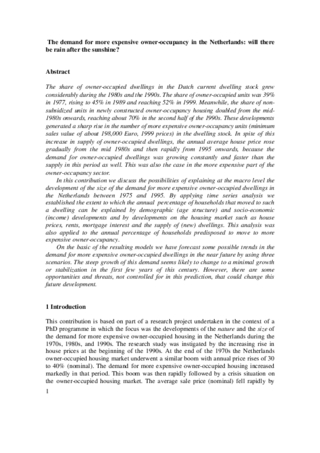The share of owner-occupied dwellings in the Dutch current dwelling stock grew considerably during the 1980s and the 1990s. The share of owner-occu≠pied units was 39 percent in 1977, rising to 45 percent in 1989, and reaching 52 percent in 1999. Meanwhile, the share of non-subsidized units in newly construc≠ted owner-occupancy housing doubled from the mid-1980s onward, reaching about 70 percent in the second half of the 1990s. These developments have generated a sharp rise in the number of more expensive owner-occupancy units (minimum sales value of about 198,000 Euro, 1999 prices) in the dwelling stock. In spite of this increase in supply of owner-occupied dwellings, the annual average house price rose gradually from the mid 1980s and rapidly from 1995 onwards, because the demand for owner-occupied dwellings was growing constantly and faster than the supply in this period as well. This was also the case in the more expensive part of the owner-occupancy sector. An earlier study at the micro level has shown that these developments can be partly explained by socio-economic and demographic changes in the population. But the growing demand for more expensive owner-occupied dwellings also seems to be affected by the circumstances on the housing market during the period under study. In this contribution we discuss the possibilities of explaining at the macro level the development of the size of (potential and realized) demand for more expensive owner-occupied dwellings between 1975 and 1995. By applying time series analysis we established the extent to which the annual percentage of households that has moved to such a dwelling can be explained by demographic (age structure) and socio-economic (income) developments and by developments on the housing market such as house prices, rent for dwellings, mortgage interest and supply of new dwellings. This analysis is also conducted on the annual percentage of households that is willing to move to more expensive owner-occupancy. On the basis of the resulting models we try to forecast some possible trends in the demand for more expensive owner-occupied dwellings in the Netherlands in the nearby future.
Boumeester, H.. "The demand for more expensive owner-occupancy in the Netherlands." In 8th European Real Estate Society Conference. ERES: Conference. Alicante, Spain, 2001.
Section: Tenure Choice and policy II
